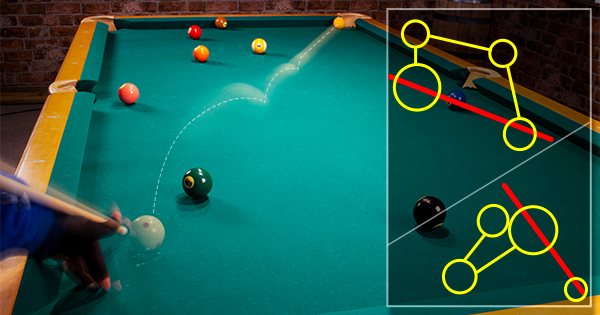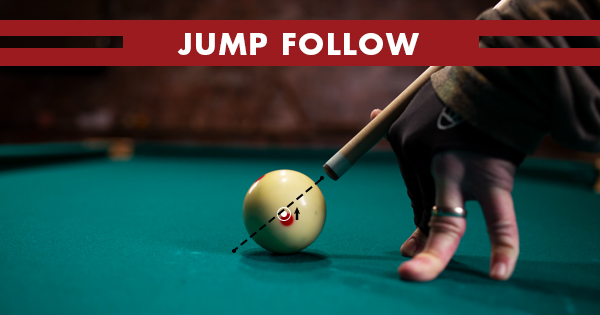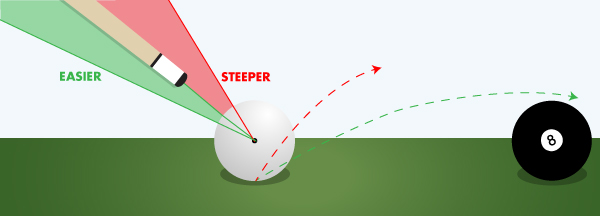
Q: "I recently started practicing jump shots and would like to get some advice on how to control the cue ball better. I can execute the jump okay, but I'm having trouble with jump/draw and jump/follow. Do you have any advice for controlling the cue ball while jumping?"
A: This is a complicated topic. Let's begin with a bit about the fundamentals of ball jumping. You need three things to jump well: good equipment, good technique, and belief that those things will work. Since you're jumping "okay," I'll assume your jump cue is good, so that just leaves techniques and belief.
There are two "standard" techniques, called the pendulum stroke (long and low) and the dart stroke (short and high). These techniques are demonstrated in the videos below. Note that many players use the pendulum method for both the long and low and the short and high shots, so there's no hard and fast rule about which technique to use, experiment and find what works best for you.
Pendulum Stroke Jump Shot:
Dart Stroke Jump Shot:
The heart of the matter here is quite literally the "heart of the cue ball." Balls jump because you send force through the core of the ball, into the table. Imagine a pearl, located dead center in the middle of the cue ball. From whatever stick angle, you are using the shot, you must point your stick directly at, or slightly above or slightly below, that imaginary pearl. Maybe this is why Earl "The Pearl" Strickland jumps so well with his playing cue? To get "jump draw" you must hit a little below the pearl and to get the "jump follow" you have to hit just above the pearl. Hit too low and you miscue and scoop-foul. Hit too high and you trap the cue ball between the tip and the cloth and it doesn't jump. At first, many players have difficulty pointing their elevated stick accurately at the pearl. Have a friend stand to the side of your shot and tell you when you are pointing at the pearl from various stick angles.



 Frank Says: "Working on your jump shots and worried about damaging your cloth? You have to check out Stefano Pelinga's Cloth Shields. They're designed to protect your cloth against tears and burn marks while practicing."
Frank Says: "Working on your jump shots and worried about damaging your cloth? You have to check out Stefano Pelinga's Cloth Shields. They're designed to protect your cloth against tears and burn marks while practicing."
Your stick elevation angle is an important piece of the puzzle. Most players I see elevate their stick more steeply than necessary. I think this comes from watching the trick shot pros doing extreme things. If you think about it, you'll see that as you elevate more steeply, you're hitting more on top of the ball, so it gets progressively harder to break the friction with the cloth. To get backspin, you must break the friction. This is easier as you elevate less. To get follow, you have to hit above the pearl, but not so far above it that the ball fails to jump. Again, as your stick angle gets flatter, this gets easier.

Given that you say you're only clearing the blocking ball half of the time, I'd suggest you keep working on basic jumping for a while before expecting to be precise enough to manage jump-draw and jump-follow. And try less stick elevation. If elevating less doesn't work, you may need a better jump cue.
My suggestion is to get a big pile of books and magazines and use them to make practice "jump humps" on the table. Build humps of various height and lengths and jump over them. Visualize the arc of the cue ball through the air, shoot it and see what actually happens. Did your ball travel the way you expected? Did you hit a book on the way up? Did you land too early? This exercise will teach you to estimate the appropriate stick angle, speed, and cue ball contact point for all types of jump shots.

One more tip for jumping. It's the opposite of what your testosterone wants you to do. Don't muscle the shot. The lighter the grip, the better the flight. Try it and see for yourself.
- RELATED ARTICLES
- Failure to Launch - 6 Tips for Better Jump Shots – By Jennifer Barretta
- How to Masse and Jump the Cue Ball – By Florian "Venom" Kohler
- Pool Etiquette: 5 Ways to Avoid Being "That Guy" – By Mikey Verkruyse